Taking the Chisel to a Major Brick Wall: What we know about P. R. Joslyn
Part II
Last month’s column was devoted to the varied avenues of research utilized in my attempt to identify the parents of my 3rd great-grandfather, William “P. R.” Joslyn. That included a foray into DNA testing graciously provided by my maternal uncle. The column covered some of the most relevant research based on the best match that DNA test provided in the hopes someone, somewhere may have the answer and will respond. The research into that DNA match led to the grandfather of one we identified only as DNA Primary (with respect for the other two researchers who have expressed an interest in keeping their own identities and that of their immediate relatives private.) Edward S. Joslyn (often spelled as he must have pronounced it “Joyslin”) who was a silversmith, watchmaker, jeweler. He was, by logical deduction, not a sibling to our P. R. because of the age difference. Edward S. Joslyn was born 1826 in Cohansey Township, New Jersey. P. R.’s birthdate, according to Census records, appears to have been about 1760. That 66-year date range would indicate Edward S. Joslyn must have been, at least, two generations removed from that of P. R. Perhaps, Edward’s father was a nephew of our P. R. Only time will tell.
This column picks up with the findings twenty plus years of research into P. R.’s life has provided. This is a compilation of all the facts your author has been able to scratch out, both confirmed and documented and surmised or logically assumed in order to help with the research. Ancestry provides wonderful clues, but the dates and names and places have to be provided in order for your Search results to be fruitful. Therefore, many who look at my tree may find notations as to a certain “fact” being an assumed fact, not to be depended upon as solid. My firm belief is that we are missing a generation between William “P. R.” Joslyn and the Colonel William of Deerfield, whom we propose as P. R’s grandfather not his father because of the advanced age of both William and Christiana by the time of his birth.
Recently, your author received an email from another Joslin researcher, one David Joslin, who provided an exciting find: a photograph of the ancient headstone he believed to be that of our grand-matriarch Christiana Garrison Joslin, mother of William “P. R.” Joslyn, wife of the Colonel William Joslin of Deerfield. The almost illegible engraving on that headstone appears to say
“In memory of Christiana daughter of Jacob (illegible) who departed this life December (illegible) 1762 Aged 46 years and 28 Days”
The date of death could coincide with the possible birth of William, a late in life child whose mother may have lost her life in creating his. The dates, when checked against known facts in William’s life, match the ages well, however, there are issues. Issue ONE: the first child born of the union of the Colonel William of Deerfield and Christiana, Jacob, who would have been born (given this set of facts) at the impossibly youthful age of ELEVEN. Issue TWO: Further research found this photograph to have been originally posted to a tree belonging to Joseph Champney. The photo appears with the following information:
“Garrison Christiana - Upper Pittsgrove, Salem County, NJ - Birth: Nov. 17, 1716 Death: Dec. 15, 1762 Salem County New Jersey, USA Aged 46 years and 28 days 1st wife of Joseph Champneys. Parents: Abraham and Katherine Garrison of Cumberland Co, NJ”
A huge disappointment. But I have now removed the photo from my tree lest other researchers be led astray. Our best information is that she was born in 1702 and died in 1757. SOURCE: http://www.myheritage.com/names/christiana_joslin
And, so it goes, as one promising lead after another fades into a whisper of smoke. Thus, we rely on those facts that have the best hope of finally unearthing that one clue that will be used to chisel down the brick wall.
We left P. R. and his family in 1830, residing (per the US Federal Census) in Berlin, Knox County, Ohio. From a study of documented records for P. R. and his many children, we shall attempt to create a timeline of travels, embellished with applicable facts and stories.
1790-1810 (?) – NEW JERSEY:
Before beginning their migration from New Jersey, P. R. and wife had children: It is believed our 2nd great-grandfather, Riley, was the eldest. Census records indicate he was born about 1795 either in New Jersey or, by one census record, in Pennsylvania. No birth record has been discovered. IF the marriage recorded between a William Joslin and Lois Bennett is for our William “P. R.” we can assume Lois Bennett Joslin was the mother of Riley. Lois and her little baby boy William are found to have died in Cumberland, NJ on 6 January 1797. Another marriage is recorded 6 Mar 1798 for a “William Joslin and Sally Irwin” in Cumberland County, New Jersey. The author has chosen to include both marriages as POSSIBILITIES in order to further our research, but no confidence exists as to their applicability to William “P. R.” Joslyn. Several William Joslins resided in Cumberland County, NJ, at that time and these marriages could apply to one or more of them. Many records in the Cumberland New Jersey area were lost to fires. Only due to a concerted effort on the part of historians and genealogists have alternate records been located, scanned, indexed and provided online. Long discussions have revolved around this issue of attribution of maternity to these women. The only name most researchers agree upon as the wife of P. R. is Rachael, whose maiden name has been lost to posterity. It is the author’s belief Rachael Unknown (poor dear) is the mother of all the children.From records we find that P. R. and wife Rachael (presumably) had more children while living in New Jersey. Places of birth and approximate birth years have been gleaned from the available records for these children: Riley (b. ca 1792-d. 1871) m. Eunice Evans, Josiah (b. 1799-d. 1886) m. Margaret “Peggy” Carnahan on 9 Nov 1822 in Knox County, Ohio, William (b. ca. 1802-d. 1880) m. Sarah Williams 1831 in Indiana, Daniel (b. ca. 1803-d. 1826?) whose relationship is surmised and whose life is shrouded in mystery; and Sarah (b. abt Sep 1803-d. aft 1873). Sarah married Jacob Kinney 7 Feb 1822 in Knox County, Ohio. By the 1830 Census Sarah had given birth to six children. We have no confirmed death date for Sarah, although a newspaper clipping dated 10 Jul 1873 found in The Cambridge City Tribune (Cambridge City, Indiana) picked up from the Shelbyville Volunteer reports: “Mrs. Kinney, widow of Jacob Kinney, who was so badly gored by a cow some time since, that her life was despaired of, is rapidly recovering. (Shelbyville Volunteer).
1810 – 1831/32 (?) OHIO:
(1820 US Census in Morgan, Ohio; 1830 US Census in Berlin, Knox County, Ohio)After the family’s migration to Ohio, children continued to arrive on a fairly regular basis. The dates and places of birth, as for the first named children, have been determined by research into Census, birth, death, marriage and other available records. The children believed to have been born in Ohio are: Rachael (abt. 1810), Rachael married John Barnhill on 24 Jan 1828 in Knox County, Ohio. It is believed she and John moved to Stark County, Illinois before her death about 1848, preceding his 2nd marriage.
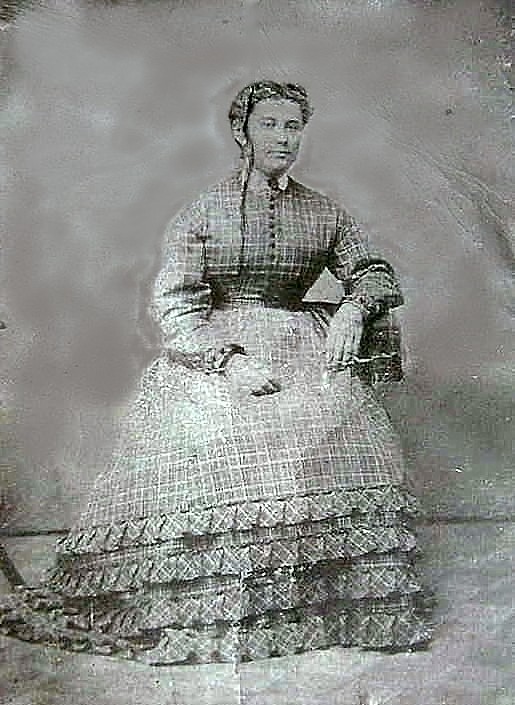
|
Rachael Joslin Barnhill. Photograph originally submitted to Ancestry.com by KaySchleich 22 Dec 2010 from the collection of her grandmother, Hallie E. Barnhill Johnson. The photograph was marked “Rachael Joslin Barnhill.” It is believed the photograph was taken in Illinois in about 1838.
Next we believe Elizabeth arrived in 1811. On 20 Jan 1831 in Knox County, Ohio, Elizabeth wed Aaron J. Barnhill, brother to sister Rachael’s husband John. Elizabeth named her firstborn son William Riley Barnell. (* NOTE 1)
(* NOTE 1: It is believed Elizabeth adopted the old Irish-English naming tradition and named this first son after her father William and her eldest brother who we have as James Riley. The first name of James arose when the author inherited a document showing William Henry Joslin, Riley’s son, had enlisted two times during the Civil War. On the reverse of that form appeared the handwritten note: “Son of James Riley Joslin.” This month’s research, however, finally resulted in the location of the death certificate for William Henry Joslin (again Riley’s son.) This death certificate had been filled out “Wm. Hy. Joslyn” by the attending physician, Dr. Johns of Pineville. The informant for the completion of that death certificate was none other than the author’s own grandfather, James Arthur “Artie” Joslin, who said William Henry’s father was WILLIAM Riley Joslin. To add further mystery to the information; however, was the fact that Dr. Johns had scratched through the spelling of Riley several times, changing the spelling to “RGley’ but also indicating the mother was Eunice Evans RGley. Ahh, the puzzling matters we encounter in our research!
Is this a significant clue to the real name of William “P.R.” Joslyn? Is it possible the nickname of P.R stands for “Papa Riley” to differentiate between him and son William Riley who went by Riley?)
1831 – 1835: - INDIANA
Although the next child born in Ohio appears to be Hetty (b. 1812 in Ohio, d. before 1846?), her marriage marks one of the first records of the family in Indiana. Hetty married Samuel Pope Meloy 19 Dec 1832 in Shelby County, Indiana just eight days after brother Isaac wed Nancy Pate. Hetty’s last child, Lorinda, was born in Missouri in 1842. In 1847 Hetty is no longer found in any records and Samuel has remarried. After Hetty, Phoebe was born in Washington Co., Ohio on 10 Apr 1813. Phoebe (Phebe) married Henry Ensley 23 Jul 1833 in Shelby County, Indiana. She died 17 Sep 1902, in Elmore, Knox County, Illinois, one of the few of the Joslin daughters to live to a ripe old age.Isaac Joslin was also born in Ohio (1814 in, perhaps, Morgan, Ohio where the family was enumerated in 1820), but married Nancy Pate 11 Dec 1832 in Shelby County, Indiana.
1836-1846 – ILLINOIS (1840 Census facts: Name Wm Joshlin, Home in 1840: Kane, Illinois. Household consisted of one free white male aged 20-29 and one free white male aged 70-79; one free white female aged 60-69 a total of three (3) in the household, one of which was engaged in agriculture.)
Obviously, due to the advanced age of Rachel (60 – 69 years by census), no more children’s births can mark the family’s arrival in Illinois. It should also be noted no record of Rachael exists after this 1840 Census. P. R. arrived in Kane County Illinois in 1836. The frontier was raw, without established conventions of county clerks, records scrupulously maintained of births, marriages, and deaths. We are in luck, however, because several Kane County, Illinois, histories report P. R.’s story.
Illinois was first explored and claimed by Frenchmen, a claim disputed strongly by the English who proclaimed the country, coast to coast as property of the King of England. The French and Indian wars fought 1754 to 1763 resolved the issue, for a period of time. The Revolutionary War would once again challenge ownership, finally vested in the newly formed United States of America.
“The coming of the pioneers, who swept like a wave over the middle western states after the French and Indian war, reached northern Illinois about 1830, during the first administration of Andrew Jackson as president. The general population of the United States then numbered about thirteen million having more than doubled since the War of Independence; mostly by natural growth, the later foreign immigration not having yet begun. The center of population was near the west line of Maryland. It is now near Indianapolis, Indiana. Less than ten per cent of the people lived in cities of over 8,000. Now over fourty-five per cent are in such cities.” (Source: History of Kane County by Joslyn & Joslyn, 1908)
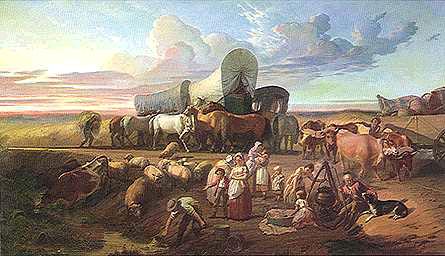
|
Early Pioneers Arriving Kane County – 1830-1840 |
Thus, the first lands offered in Illinois were “Government lands”. We are offered glimpses of the land by virtue of a letter written 10 April 1840 by one Daniel Pingree to a friend back in his home state: Excerpts from this letter bring to life the geography, the attraction and the beauty of the countryside that beckoned to our ancestor and his heirs:
“…in my opinion you could not find a better County in all the world for farming.”
“There are 3 kinds of Prairie, high rolling, medium, and wet. The first mentioned has a rich productive soil generally of a brown color consisting of loam with a mixture of light colored sand, and in many places are knolls, natural mounds, elevated from 10 to 30 or 40 feet with a regular oval shape, and sometimes contain an area of 1 or 2 acres but generally much smaller. These are composed principally of gravel and produce but little. This kind of Prairie is excellent for all kinds of grain, but not very good for grass. The natural grass does not grow very large and it is thought from the trials that have been made that the English grass will not do well; it is to dry. Another objection to them is a scarcity of water. It can however be obtained by digging from 15 to 40 feet. So you see that a farm composed wholy of this kind of Prairie would not be the place for keeping stock to advantage.
“The soil of the Medium Prairie is much like the Rolling as to the material of which it is composed. It is of a darker color and as much richer as it is darker and is not interspersed with any of the above mentioned knolls. It is generally slightly oval so that the water which is not absorbed will run off sufficiently. It will produce abundantly anything that a farmer wishes to put into the ground. This kind of Prairie is generally interspersed with Creeks and small Sloughs which afford a plenty of water for cattle etc. These sloughs produce natural grass in any quantity almost; some of them I think produce 4 or 5 tons per acre! Water on medium Prairie can be obtained by digging from 10 to 25 feet.
“The Wet Prairie consists of a very rich, black loam and is generally mixed with a light colored sand, and is particularly adapted to the growth of Corn, it being too rich for wheat and most of the other kinds of small grain, butt is great for grass both natural and English.
“The Timbered land is generally Oak-Barrens, called by some Oak Openings. The Timber of the openings consists of several kinds of Oak; viz: Black, Yellow, White, Pin, Red and Bull, and in many places there are a plenty of Hickory or walnut trees, occasionaly a small grove of Poplar. There are some groves of timber in this section of the County that contain almost all the kinds of timber that there are at the East with the exception of Spruce Hemlock and Pine. The timber of the openings is short, many of the trees will make but 1 rail cut, but some will make 2 or 3.
“There is an excellent opportunity in this section of country to claim Government Land, this you can have for $1.25 per acre, and pay for it immediately after you settle on it if you please, or you can have one years Pay Day if you choose. This is according to the last Pre-Emption Act. The above are the conditions for purchasing land that is already in market. Or you can settle on land not in market and Pre-Emption it any time befoer the day of Sale…You can buy claims of 160 acres where their is a log house and 10 or 15 acres plowed and fenced for from $200 to $1000 and perhaps upwards just according to location… People generally hold claims high but want of money sometimes compels them to sell cheap. I know of one man who has 160 acres of Deeded Land with a pretty good log house on it and 4 or 5 acres plowed that he offers to sell for $400 and perhaps there are chances equally good.
“There are some Prairie volay beer about as large a decent sized dog. They do no harm with the exception of taking some pigs an sheep they never touch a man. There are Land-Hile-Cranes that Halloo so that they may be heard 2 or 3 miles. Prairie Hens about the size of common hen. Wild geese, and ducks, foxes, Badgers. There are no Wood-Chucks.
“I think if I were coming from Ky. to Ill. to commence a farm that I should come in Spring. We are situated on the State Road leading from Chicago to Galena which is called the Great Western Mail Route from C. to G. We are only 43 miles from Chicago, and 7 West of Elgin on Fox River, and 3 west of Udina, our Post Office. The Stage on this route passes our door 6 times in a week and there is a great deal of Public Travel.” (Source: Letter written by Daniel Pingree, Udina, Illinois, to Samuel C. Rowell, Lower Blue Licks, Nicholas County, Kentucky)
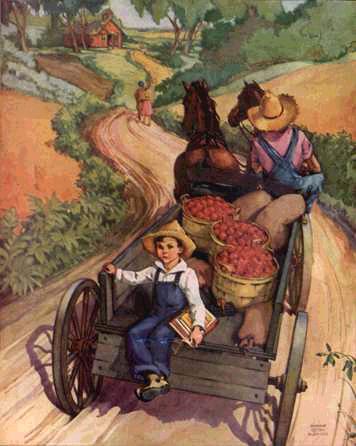
|
Kane County Illinois – Taking Goods to Market |
From the History of Kane County, by Joslyn & Joslyn, published 1908 we discover when P. R. Joslyn arrived. The county was brand new. P. R. was a pioneer, ever forging his way Westward seeking new land and better opportunities for his family. Kane County was established in 1836, the year P. R. Joslyn arrived. This history reports:
“In 1836 when Kane County was established this area was part of the Pleasant Grove precinct. Today, Lily Lake residents attend Burlington Schools, but are in located in Campton Township. Most have a St. Charles address.
1835 - STEPHEN VAN VELZER claimed nearly the whole township. Settlers who followed were forced to buy land from him, or face controversy.
1836 - P.R. JOSLYN came from New Jersey
1837 - RILEY JOSLYN, son of P.R. JOSLYN arrived from New Jersey.
(Source: History of Kane County by Joslyn & Joslyn 1908 located on the website:
Kane Co History in rootsweb)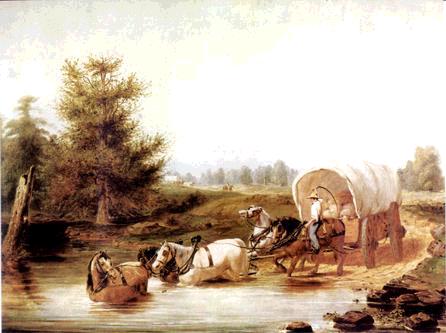
|
Harrington’s Ford on the Fox River - Illinois |
We are fortunate in that other histories paint a better portrait of P. R. Joslyn and his strength of character in the face of adversity.
“STEPHEN VAN VELZER appears to have made the first location in the township and, unfortunately, made the preposterous claim to an area of about twelve miles square. This must have retarded settlement, as many quarrels resulted in consequence, while a number of settlers paid him something for his pretended claim to avoid contention. He came in 1835, as also did ALLISON BANKER. In 1836, SOLOMON WRIGHT and his three sons, BALDWIN, ELISHA and D.C., and a daughter who soon married BANKER, arrived from New York; also P.R. JOSLYN from Indiana, who with his son RILEY, settled upon a portion of Van Velzer's claim in defiance of his objection.”
(Source: Historical Encyclopedia of Illinois (Edited by Newton Bateman, LL.D. and Paul Selby, A.M.) and History of Kane County Edited by Gen. John S. Wilcox. Chicago; Munsell Publishing Company, 1904, pp. 705-707)
“P. R. Joslyn, a kind of migratory character, but a good man withal, settled in the town in the early part of 1836. He was originally from New Jersey, but had lived in Ohio, Kentucky and Indiana. From the latter State he came to Burlington. He had some difficulty with Van Velzer, in regard to his claim, who attempted to collect a sum of money from him as a bonus for the privilege of settling on it. Upon inquiry, he learned that Van Velzer had no just grounds for such demands, and so he settled upon the claim selected, in open defiance of him. His son, Riley Joslyn, came the next season, and took up a claim in the township.”
And later in that same History, the following appears:
“THE FIRST DEATH.
Each moment, in dying. bears with it a dead human being. Flowers perish and spring again, suns set at eve and rise again in the east, but the dead render not up their dead to mortal eyes. Death, the grand leveler of human greatness and human ambition, entered the infant settlement at an early period of its existence. Van Velzer's wife was the first victim of the grim tyrant. She died in 1837, and was buried amid the wild flowers of her prairie home. A native of the sunny South, her tender frame was unable to withstand the fierce winds of a colder clime. Others of the early settlers in time followed her to the better land. Joslyn, perhaps, was one of the first, and died about 1846-7.”
From another source another interesting tidbit emerges: “The first death in the settlement was that of VAN VELZER'S wife, in 1837. She was a Southern woman and brought with her a Negro slave who served her mistress faithfully but soon after her death, the slave returned to her old home in the the sunny South land.” (Source: Historical Encyclopedia of Illinois, ibid.)
Yes, the life was difficult, the privations many, the adjustments to life on the prairie versus city life back on the cultured Southern plantations would have been hard on a woman not accustomed to any hardship at all. After traversing the plains and the prairies, making their way through the forested lands still occupied by many an Indian angry at the White Man for taking their lands, the travelers had to live for awhile in the ancient version of an RV park. Note the living accommodations illustrated in this painting from the Kane County, Illinois Genealogical website:
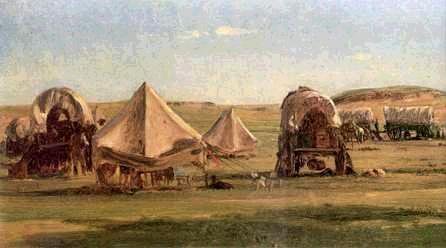
|
Settlers Arriving from the East – First Homes |
Future Research Avenues
Our research has shown William “P. R.” Joslyn migrated from New Jersey, to Pennsylvania, to Ohio, Indiana and into Illinois. But this last quoted history indicates he also “lived in Kentucky.” One of my early research cohorts was Joyce Schumacher who had become fascinated with a Joslin family in Kentucky whose children’s names were almost identical to our family lines’. After Joyce’s death came the opportunity to submit DNA and hope for results in closing those gaps in our knowledge of our personal history. My maternal Joslin uncle was kind enough to submit his DNA for that very purpose. As discussed in the first Part of this story, that DNA provided the closest match with one Westcott Campbell Joslin who started life in Camden, New Jersey, but who is linked to Paducah, Kentucky through the travels of his great-grandfather, Edward S. Joslyn (often spelled “Joyslin” perhaps because of the New Jersey accent). In fact a search through the Census records resulted in a possible “find” – an Edward Joplin where inspection of the original handwriting appears to be Joyslin, in Garrard, Kentucky:
Name Edward Joplin (looks like Joyslin)
Home in 1840 (City, County, State) Garrard, Kentucky
Free White Persons - Males - 5 thru 9: 1;
Free White Persons - Males - 60 thru 69: 1;
Free White Persons - Females - 20 thru 29: 2;
Free White Persons - Females - 60 thru 69: 1;
Persons Employed in Agriculture: 4;
Persons Employed in Manufacture and Trade: 1;
Free White Persons - Under 20: 1;
Free White Persons - 20 thru 49: 2;
Total Free White Persons: 5;
Total All Persons - Free White, Free Colored, Slaves: 5.
There is also a very interesting connection between John Chapman, better known as “Johnny Appleseed” whose travels mirror the dates and places quite eerily of our P. R. Joslyn. Preliminary research finds a further connection: Nathaniel Chapman, father of John Chapman, lived in Leominster, Massachusetts, was a Revolutionary War hero who served with General George Washington at Valley Forge. He served under our Joslin relative, John Joslin:
Nathaniel Chapman, Leominster. Private, Capt. John Joslin's co. of Minute-men, Col. John Whetcomb's regt., which marched on the alarm of April 19, 1775, to Cambridge; service, 11 days; reported enlisted into the army; also, Capt. David Wilder's co., Col. Asa Whitcomb's regt.; muster roll dated Aug. 1, 1775; enlisted April 26, 1775; service, 3 mos. 13 days; also, receipts for wages for Aug. and Sept., 1775, dated Prospect Hill; also, company return (probably Oct., 1775).
(SOURCE: wikitree.com/Chapman).
It seems your author’s research into the life of William “P. R.” Joslyn may have just begun!
Researched and compiled by Melinda Cohenour






No comments:
Post a Comment